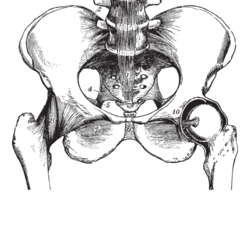
Pelvis Problems is a series created and written for Scarleteen by Caitlyn Tivy, a pelvic health physical therapist, that focuses on health issues she encounters in her work as a PT and what readers living with them can do about them.

Pelvis Problems is a series created and written for Scarleteen by Caitlyn Tivy, a pelvic health physical therapist, that focuses on health issues she encounters in her work as a PT and what readers living with them can do about them.
When I tell someone that I help people with problems related to the abdomen, pelvis, and pelvic floor, I often get a curious look. What is the pelvic floor, after all? How do we care for it and the tissue around it? Here’s a thorough walkthrough of the anatomy of your pelvic floor and perineum and how you can keep tabs on this area of the body.
This edition of Pelvic Problems covers one of the most common problems that pelvic health physical therapists encounter: the non-relaxing pelvic floor (NRPF). This can cause a variety of symptoms, ranging from constipation and difficulty peeing to pain with sex and sitting. Fortunately, there’s a lot that can be done to help people with non-relaxing pelvic floors!
This installment of Pelvis Problems from Caitlyn Tivy, the pelvic health PT, talks about interstitial cystitis (IC) and chronic prostatitis (CP), disorders that can cause pain with peeing, along with a number of other symptoms, what causes them, how they can be diagnosed and how they can be treated so you can pee without pain again.
Endometriosis is a complicated and often debilitating condition. It’s believed to occur in approximately 10% of people with uteruses of “reproductive age." That’s approximately 200 million people worldwide – a whole lot of folks! About two-thirds of people with the condition will develop symptoms before the age of 20, but it may take several years and consultations with multiple healthcare providers to receive a diagnosis. One of my missions in spreading awareness about endometriosis is to help more people receive a diagnosis and appropriate care more quickly.
Ads on TV often give the impression that bladder leaks only happen to old ladies who’ve had a bunch of kids. However, urinary incontinence (UI) affects people of all ages, genders, and activity levels. There are many different types of UI, but one of the most common types affecting young people occurs during physical activity and athletics – hence the term “athletic urinary incontinence.”
If you're here because you or your partner(s) have experienced pain with anal sex, you’re in the right place, regardless of whether the pain has happened multiple times or just once. I’m here to shine some light on anodyspareunia, a fancy name for anal sex being painful.
Physical therapist Caitlyn Tivy talks pelvic exams in the current era: what they are, why you might need one, and how to make them a comfortable and positive experience, including modifications that can be made with them that you might want or need.